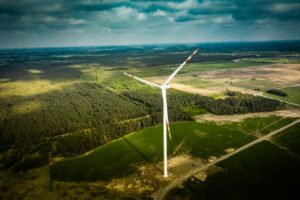The value of Polish exports of devices for generating energy from renewable sources is similar to the value of exports of machinery in the coal energy sector. At the same time, global trends indicate a declining potential of trade in goods related to coal-fired energy. It is worth considering these trends when shaping Polish economic and energy policy to support this branch of the economy on more prospective global markets – writes Marek Wąsiński, analyst at the Polish Institute of International Affairs (PISM).
The combination of ambitious climate policy with economic policy plays a significant role on the world stage and such trends are apparent in the EU,[1] in U.S. states (e.g., California), and in China. Clean technologies are not only meant to contribute to the low-carbon transformation of an economy but also to boost it, including exports. The share of exports of equipment for the production of energy from coal and renewables accounts for about 4% of the total world export of goods.
Poland Vis-à-vis World Leaders
The biggest exporter of devices used in the production of energy from coal—including steam turbines, generators, and boilers—is China, whose share of global exports in 2016 was 15% ($4.6 billion).[2] The next major exporters of this kind of equipment are Germany ($3.7 billion, 12%), the U.S. ($3.5 billion, 12%), Japan ($2.5 billion, 8%), Italy and South Korea (both about $2.2 billion, 7%). Despite significant investments in coal-fired energy sources in Poland, exports of this equipment in 2016 amounted to $0.5 billion, or 1.7% of global exports and 0.3% of total Polish exports.
On the other hand, exports from Poland of equipment for generating energy from renewable sources (RES, including wind and water turbines, generators, and photovoltaic panels) was smaller but amounted to $0.3 billion, or 0.3% of global exports of these goods (0.2% of Polish exports).[3] Global trade in these products has been dominated by China, which accounts for 26% of total exports (over $22 billion). Germany, second after China, has 10% ($8 billion), followed by Japan and Korea, 7% ($6 billion), and the U.S. at 6% ($5 billion).
After extending the list of this equipment to include devices and products related to the production of energy, such as metres, transformers, filters, conveyors, and construction elements, the overview of the most important exporters remains similar. However, Poland’s share in world trade in this equipment is higher in the case of devices and products related to coal energy, to 2.1%, and in RES, to 1.5%. In nominal terms, the export flows from Poland of both are alike, amounting to $7 and $6.8 billion, respectively.
World Markets and Trends
The value of global exports of devices for energy generation from renewable sources in 2016 amounted to $85 billion while exports in the coal-based energy sector were almost three times smaller and amounted to $30 billion. It should be emphasized that in 2007–2016, the export of RES-related machinery noted higher average annual growth— 9% compared to 3% in coal—which translated into a four times stronger increase in RES in the whole period—by 74%—while coal was at 17% (Figure 1).
Trends in investments and newly installed capacities show a similar path. According to the International Energy Agency, in 2017, RES accounted for half of the net new power capacity. It grew by over 6% in 2017 while coal-generation capacity, after two years of decline, increased by only 1%. Bloomberg New Energy Finance forecasts that of $11.5 trillion of investments to be made in new power generation capacity by 2050, $8.4 trillion will go to solar and wind energy, $1.5 trillion for other low-emission technologies, and only the remaining $1.6 trillion to fossil fuels.
These changes are driven by two factors. The first is the plummeting cost of production of energy from RES. Excluding expenditures for power grids, these technologies have become more competitive than coal sources. The second factor is climate policy, which leads to a transformation to low-emission energy. According to the Paris Agreement, all parties pledged contributions to take action to limit climate change. The EU, as well as China and India, count on additional benefits from investments primarily in RES.
Potential of “Clean Coal” Devices
The most important exporters of products related to, among others, the capture of greenhouse gasses (GHG)—filtering devices, furnaces, and parts for coal-fired power plants—are Germany ($7 billion), the U.S. ($4.2 billion), and China ($3.7 billion). The value of global exports of these products in 2016 was $33 billion. Poland’s exports of such devices are worth $0.48 billion. Polish exports of these products is growing—by 35% compared to 2007—but slower than the entire market (45%) or the growth in exports of the leaders—over 50% increase for Germany and the U.S., and over 400% for China.
Due to the efforts to reduce GHG emissions and ongoing investments in new coal power plants, this market also has growth potential. At the same time, the reduction of GHG emissions will be important, not only in regard to coal but also to gas or biomass. Despite this, the increase in exports of this equipment since 2007 is slower than for RES appliances (45% compared to 74%), while the market for devices to generate energy from renewable sources is almost three times larger. The growth potential of this market also might be affected by the same two factors: political decisions as well as the competitiveness of other energy sources.
Conclusions
The dominant role of coal in the Polish energy mix is not reflected in the structure of Polish exports. Equipment for energy generation from fossil fuels are not a Polish export specialty and their nominal value is slightly higher than exports of equipment for obtaining energy from renewable sources. While the role of coal in the global economy will decrease, and with it the market of goods related to this technology, the export market of RES products is already larger and has much better growth prospects.
Global trends indicate a rapid increase in the demand for devices related to renewable energy sources. These trends should be included in Polish economic policy. Such activities may include the promotion of Polish companies (initiatives such as the renewed GreenEvo project) as well as by creating the best possible conditions on the domestic market, e.g., by considering opportunities related to the role of RES in energy and climate strategy. It is worth approaching these issues in advance to be able to influence the decision-making processes in the EU. The European Commission is preparing a long-term climate strategy that will not be limited to mitigation efforts but a vision of EU economic and social policy. Low-carbon technologies will play a key role in it. Furthermore, the strategy will become an important reference point for prospective regulations and financing plans.
What is more, the green economy is not only a potential export opportunity but also an important element of foreign policy. Ambitious activities in the field of renewable technologies as well as in energy efficiency or low-emission transport allow the creation of a positive image of the country and opportunity to determine future regulations—in the EU or others, such as the United Nations Framework Convention on Climate Change (UNFCC) 24th Conference of Parties (COP24) in Katowice in December 2018. Clean technologies and climate policy are important topics when approaching countries most exposed to the negative effects of climate change. The availability to refer to their needs translates into opportunities to cooperate with them, for example, at the UN.
Source: PISM








